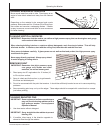
PR-Series Operator’s Manual-E/F 21
Operating the Washer
CLEANING HORIZONTAL SURFACES
Move nozzle wand from side to side. Direct spray at an
angle to force debris ahead and away from the cleared
area.
Depending on the material to be removed and nozzle
pressure, hold nozzle end 8 to 10 inches (20 to 25 cm) from
the surface and use slow, overlapping strokes. If debris
is easy to remove, move nozzle back to cover more area
for faster cleaning.
CLEANING VERTICAL SURFACES
IMPORTANT: Remember that the washer can deliver a high pressure spray that can break glass and gouge
soft wood and other materials.
When cleaning building interiors or exteriors without detergents, work from top to bottom. This will help
eliminate streaks. In interiors, start with the ceiling rst, then the walls and the oor last.
Clean around windows carefully. If glass panes are not well-caulked and puttied, the high pressure spray
could break the glass.
Never spray directly overhead. Always spray ahead
to avoid dripping or falling debris.
8" - 10"
(20-25 cm)
REMOVING PAINT
IMPORTANT: Remember that high pressure spray
can gouge soft woods and other
materials, as well as loosen grout.
1. Direct spray at a 45° angle about 4 to 12 inches (10
to 30 cm) from surface.
2. Spray in a back and forth motion, try to get beneath
the loose and bubbled paint.
3. Do not be concerned with the paint that remains. It should be sufciently bonded so as not to cause repainting
problems.
4. Some remaining paint may curl up at the edges. These edges should be scraped with a steel brush or scraper
just before painting.
CLEANING RADIATOR FINS
IMPORTANT: Some engine and radiator manufacturers
may not permit cleaning radiators with a
high pressure washer. See equipment
Operator’s Manual.
1. Use clean water without detergent.
IMPORTANT: Spray straight into the radiator to prevent
bending ns.
2. If possible, direct spray in the direction opposite to
normal air ow through the radiator.


















